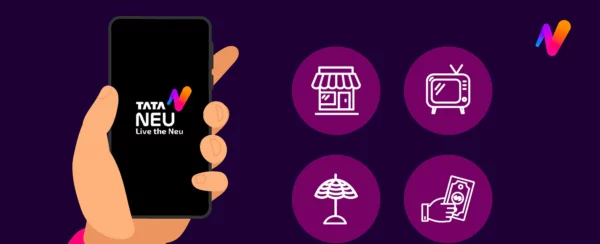After the success of Amazon, Flipkart, Reliance and Tata Neu, India’s $133 billion eCommerce market may be too little for a fifth player

After Amazon, Flipkart, Reliance and Tata Neu, India’s $133 billion eCommerce market may be too little for a fifth player
Every major Indian corporation has been vying for a piece of the eCommerce pie, which is estimated to reach a half-billion consumers by the end of the decade. Everyone has left no stone to dominate customer demand and mind space, whether Amazon, Flipkart, Reliance JioMart, or Tata Digital’s latest mega app Tata Neu.
According to a new analysis from JM Financial, we may soon run out of room to host any additional gamers. The addition of another huge player into the already “saturated” e-commerce industry, according to the Indian financial services firm, could instead lead to more consolidation, which would be bad for smaller businesses attempting to build a name for themselves.
“Me-too” players who are smaller are likely to lose out. Furthermore, to preserve leadership, these vast firms are continuing their search for specialised e-commerce players to cover portfolio gaps. Moreover, we could see them acquiring e-commerce enablers, such as logistics, data analytics, and so on, to promote organic growth,” according to the report.
Meanwhile, Bernstein believes that Indian e-commerce would not be a “winner take all” opportunity due to poor eCommerce penetration in many categories and client segmentation. Ecommerce is the largest segment of the Indian internet, according to the private wealth management organisation, and is predicted to rise more than five-fold to $133 billion by 2025.
Tata Neu may eat into Amazon, Flipkart and Reliance’s share
Tata Digital’s super app Tata Neu, which unifies all of the company’s digital services and apps on one platform, is the most recent to enter the fray. None of the brands or banners offered under the super app is new; the company has benefited from their unification under one banner, particularly when it comes to product personalization.
According to JP Financial, Tata Neu sells about 95 per cent of all e-tailing segments, including electronics, clothing, shoes, and groceries, through brands such as Westside, Tata CLIQ, Croma, and BigBasket. The portal also sells plane tickets and jewellery, and it plans to expand its product lines and brands in the future. By the end of the decade, sales are estimated to reach $20 billion.
Tata Neu announced that in the first week of its April 2022 launch, it received 2.2 million downloads.
According to the survey, Tata Neu is well-positioned to grab market share from existing competitors such as Flipkart, Amazon, and Reliance Retail. JioMart was created by Reliance Industries in 2019 to sell groceries online. It competed with BigBasket (now owned by Tata) and Zomato-backed Grofers (now called Blinkit).
To compete with Amazon and Flipkart, Mukesh Ambani’s company chose to expand JioMart’s portfolio to include clothing, accessories, household items, and more.

About Tata Neu
Tata Neu is a super app that combines the Tata group’s most trusted brands into a single super app with special privileges and advantages across categories.
What is Tata Neu?
Tata Neu is a shopping app that aims to provide clients with a comprehensive yet highly personalised buying experience. It can genuinely be considered a super app,’ and it seeks to offer a terrific shopping experience for its users. It results from almost two years of research, development, and testing. It provides users with an unrivalled level of variety and choice by combining the Tata group’s most trusted brands into one simple platform. The breadth of items and services available is unparalleled, ranging from electronics and groceries to vacation and more.
What are the benefits of Tata Neu?
Tata Neu has a lot to offer its members, from attractive offers and an integrated loyalty programme across Tata brands to unique advantages and various payment choices. It gives clients a genuinely cross-category buying experience, allowing them to:
- With Tata CLiQ and Westside, they may update their clothing.
- Croma sells the most up-to-date technology.
- BigBasket is a grocery delivery service.
- Book an AirAsia India flight.
- Tata offers health exams.
- Make a reservation at an IHCL hotel for a luxurious stay.
- Qmin allows you to order a 5-star dinner.
What are NeuCoins?
Customers earn NeuCoins when they transact on the Tata Neu app, website, or at any of the company’s stores or hotels. They can then use these NeuCoins to make purchases in the future. One NeuCoin is worth one dollar, and there are no restrictions on how many you can earn or use.
What is NeuPass?
In a nutshell, Tata Neu’s NeuPass is an impending premium membership service that grants customers a number of special Tata brand advantages. It entitles customers to at least 5% more NeuCoins every time they shop on the app, as well as other incentives that will be revealed soon.
What financial and payment services does Tata Neu offer?
Users can earn rewards on all credit card purchases and gain immediate access to cash such as personal loans and credit lines through Tata Neu. They can also use personalised insurance plans made only for them to protect their assets and grow their fortune. It’s never been easier to pay your bills. Users can now use Tata Pay UPI to send money to friends, family members, and other connections directly to their bank accounts.
What are ‘Stories’?
Tata Neu’s in-house digital magazine is called ‘Stories.’ It aims to entertain, educate, and inspire readers by producing lifestyle-focused articles and videos of comparable quality to major newspapers. Its high-quality content speaks for itself, with a current focus on technology, fashion, gastronomy, and travel.

TataNeu could be worth $15 billion, all thanks to BigBasket, Croma and Westside
According to a report by Indian financial services firm JM Financial, Tata Digital’s super app TataNeu — which unifies all of the company’s digital services and apps on a single platform — might be worth $15 billion.
This could be a natural progression for the steel-to-tech-to-auto behemoth, which already owns retail outlets like Westside and Croma, as well as FMCG brands ranging from tea to salt and the grocery delivery service BigBasket.
“We feel the Tata ecosystem has many potential that Tata Digital can help uncover.” “We anticipate the value of Tata Digital may be excess of $15 billion based on the gross merchandise value of major categories on Tata Neu,” it added.
‘An audacious endeavour’
In fact, the study compares it to Walmart’s e-commerce pivot, claiming that it can successfully combine online and offline shopping experiences, something that both Amazon and Jio are attempting. It does, however, come with its own set of risks.
“While Tata is checking all the correct boxes in their digital transformation, the sheer magnitude of the task makes it an adventurous undertaking.” “We believe Tata will need persistent investments in this market to thrive,” the report said, citing Walmart’s e-commerce transition as an example.
More services – travel to food and more
JM Financial has also given no value to Tata Pay, its own UPI technology, or other TataNeu bubble categories like food and travel. It anticipates the company’s valuation to change as new products and services are introduced.
Existing companies such as Vistara, Air India, Tanishq, Titan, and others have yet to be added to the super app by Tata Digital.
“However, one thing is certain. According to the research, “there is a lot of value within the Tata group that Tata Digital can assist unleash if implemented successfully.”
A tenfold increase in gross merchandise value
If all goes according to plan, JM Financial estimates that TataNeu’s GMV will reach 1.54 lakh crore (roughly $20 billion at today’s exchange rate). The gross merchandise value (GMV) of essential categories on the super app was used to make this prediction.
Its GMV, or the total value of items sold during a certain time period, is currently around Rs. 16,000 crore ($2 billion).
Good competitive advantage
Due to the lack of precise data on the number of users and GMV in the early days of the app’s debut, JM Financial believes it is impossible to assign value to TataNeu appropriately. However, it highlighted that the company’s worth should be comparable to that of an e-commerce company.
TataNeu, which launched a little over eight months ago, was initially only available to 800,000 Tata Group employees and their friends and relatives. The superapp started with 120 million users and 2,500 retail stores, and an 80 million app footprint across all of its digital assets.
TataNeu, according to JM Financial, is well-positioned to grab market share from existing competitors such as Flipkart, Amazon, and Reliance Retail/JioMart.
“Tata’s leadership in the fast-growing e-grocery segment (via Big Basket) and attractive omnichannel offerings in two major eCommerce categories – lifestyle and consumer electronics – position it well to capture market share away from the market from incumbents,” according to JM Financial.

Has Tata Neu lived up to its initial hype?
Tata Group’s much-touted super app’ presents an intriguing potential for both users and the conglomerate, with a range of hooks to attract and retain clients.
The Tata Neu app, which was launched by the company’s digital unit in early April, gives users access to major brands such as
Discounts are frequently available through the “super apps” NeuPass and NeuCoins. NeuPass allows clients to have things delivered for free, while NeuCoins enable them to participate in a point-based incentive system.
The app generated a lot of talks when it first came out a month and a half ago. On the Google Play Store, it presently has over 5 million downloads and is ranked #9 in the shopping category on iOS.
However, the large number of downloads does not reveal the whole story. The ratings on the various app stores tell a different tale, but we’ll get to that later.
A ‘super app’?
Let’s start with explaining what a “super app” is and where Tata Neu falls into that cosmos.
Super applications are not a new phenomenon, but their popularity and ability to pique users’ interest in India has been a challenge.
WeChat, a popular Chinese mega app, began as a chat app and eventually expanded to include the ability to make payments, hail a car, shop, and place food orders. This great app is yet to impact the Indian market significantly.
However, there is a similar app in India. With its rewards, payments, and shopping mall features, Paytm has become a popular app. In addition, the all-in-one application did not fare well in the country.
Like other mega app competitors, Tata Neu provides a variety of services, although they are exclusive to Tata Group brands. The app does give customers the option of buying onions and booking flights simultaneously, but the absence of options to choose the provider of services or products is once again a major flaw.
You will have to wait a little longer if you want an app that allows you to shop, book tickets, order food, or make payments at a non-Tata company. Neu is the app to use until then if you want to know everything about Tata.
App’s user experience
While the app’s services and goods are limited, the user experience is excellent. It features a section of films that explains how to use the point-based reward system, get offers, handle gifting, and much more.
New users will find it easier to learn and implement different functionalities thanks to the video explainers in the tales area. However, the pleasant experience is marred by a minor lag, as the programme occasionally fails to load certain portions on the iOS platform. Software upgrades may be able to resolve this issue.
While many parts of the app offer users exciting opportunities, there is no obvious answer to the question of whether or not you should download it right away. If you want to buy or check airfares, for example, the app only provides results for Air Asia, and it even ignores effects for Vistara and Air India trips.
While Neupass makes it challenging to ignore offers, the limitation of using it with few options may not be that every user is comfortable with. Users will have to wait until UPI payments attain the same levels of adoption as other applications like Paytm, Google Pay, and PhonePe before they can use it without having to encourage their peers and merchants to do so. The only method to secure a flawless payment till then is to use scanned codes.
Users’ reaction
Despite being a new addition to the Android and iOS app stores, Tata Neu has received positive feedback on both platforms. And the reviews aren’t glowing: iOS users gave it a 2.8 rating, while Android users gave it a 3.4.
The majority of reviews, regardless of platform, are filled with concerns about app issues, bad customer service, and even a lack of greater connectivity with BigBasket and Westside. When writing this review, these brands were only available as webviews.
Users have also expressed dissatisfaction with the inability to transfer points from other Tata apps, such as Westside, to the Neu app.
As a “super app,” Tata Neu’s branding, interface, and absorption of the conglomerate’s products and services currently fail to impress.

E-commerce in India Is Booming
E-commerce is experiencing a worldwide revival, and E-commerce in India is expanding, thanks partly to improved internet availability in India and other rising nations. This opens up a wide range of business prospects, causing firms to become more up-to-date and competitive.
India’s massive and still-growing internet user base includes rising penetration into rural areas. This bodes well for the future of e-commerce. Consumers have been acclimated to the online platform, enabling easier transactions and delivery at the selected location, whether ordering e-tickets from Indian Railways or fast-moving consumer goods (FMCG) and other lifestyle products.
The progressive shift in Indian consumers’ purchasing habits led to a proliferation of e-commerce startups. Online retailers have retained and extended their customer base by offering payment on delivery and return policies and appealing deals and discounts.
According to reports, some of the top firms in India’s e-commerce market are in the $100-million club. Amazon is a well-known player, but Flipkart, Snapdeal, Ola Cabs, Paytm, InMobi, Zomato, Quikr, and many other startups are driving the sector forward.
Scope of E-commerce Boom In India
According to NASSCOM, India’s $14 billion e-commerce economy, which began as a niche industry a few years ago, has gained traction and is growing at a rate of more than 25%. The largest segment is online travel, accounting for over 70% of the market and is expected to grow. Social media, which provides a mechanism for advertising and getting comments, creating a brand image, and promoting new launches, is allowing e-commerce to reach out to the broader public.
Online retailers also use social networking to track first-time and repeat product consumers. Consumer lifestyles and spending patterns can now be studied via social media.
Consumers are benefiting greatly from e-commerce, which is being fueled by digitization and internet penetration in rural areas. Competitive rates, exclusive offers, and prompt delivery, combined with the convenience of skipping huge lines, have revolutionised the shopping experience. According to NASSCOM, India’s e-commerce business is expected to reach $200 billion by 2030, thanks to rising analytics, transactions, and internet penetration.
In India’s retail industry, e-commerce revives customer demand and stimulates growth. The emphasis has changed from a pricing approach and a value-added model. The most popular categories among the fastest expanding domestic segments include tours and hotel reservations, airline and railway tickets, and leisure and entertainment-related products. The “e-tail” market’s new business strategies attract more return clients. Even though the e-commerce industry is booming, a large section of the populace is unaware of its advantages. For e-tailers, this represents a big untapped market.
One of the key drivers that cannot be disregarded, among many others, is product availability. In smaller cities, where consumers may be limited to a limited number of brands and possibilities, internet shopping, with its variety of delivery options and the ability to get exactly what they want, has a greater appeal.
E-commerce enterprises will benefit from a strong supply chain and a well-established reverse logistics network in India. E-commerce companies and other businesses have specific logistical needs that typical logistics providers may not be able to meet.
Generally, courier businesses that transport documents do not have experience delivering commercial products. As a result, e-commerce businesses are forming their own delivery networks. Flipkart’s logistics, dubbed “eKart,” is one such example. On the other hand, logistics vendors like Express Logistics deliver bulk loads to retailers and distributors. They have a pre-established working relationship with the dealers, enabling good execution.
Strategies for the E-commerce Boom in India
The spending power of millennials (Generation Y), the influence of the internet, which has led to the development of many mobile applications and websites, and the much-needed infrastructure has all contributed to the rapid rise of e-commerce in India.
In India, mobile penetration represents a large market, making it easier for people to buy a wide range of retail products.
Other variables that contribute to the industry’s growth include:
· Ease of access: As internet usage becomes more economical and cellphones become more prevalent, access becomes easier. Other services, such as train/hotel/cab/movie ticket bookings, cellphone and energy bill payments, and so on, are made possible through this link.
· Connecting the financial system: E-banking and other methods are now widely used. The financial system will soon be entirely digitised.
· The global reach of homegrown companies: Indian e-commerce startups are leveraging global platforms to expand their consumer base and expand their growth opportunities.
· Attracting repeat customers: A strong emphasis on customer service is critical in attracting and retaining customers. Cash on delivery (COD), affordable pricing, bargains and discounts, speedier delivery turnarounds with zero fees, and reverse logistics are just a few factors that propel the industry forward.
· Leveraging technology for innovation: Information sharing across all supply chain players is critical. Integrating various supply chain features will give the e-commerce company a competitive advantage. Bar-coding in logistics systems, EDI for interacting with partners, insight into operations, and tracking and tracing items at any given moment are all possible initiatives.
· Analytics: The essence of this industry is capturing real-time data and understanding purchasing dynamics. Customer data can address customers’ purchasing preferences, tastes, and demographics. Analytics are required to derive customer insights, optimise channels, and compute ROI due to the volume and complexity of data.
E-commerce Challenges in India
While this industry has a lot of potentials, several issues need to be solved. The following are some of the factors that limit growth:
Logistics: One of the primary issues facing e-commerce firms is logistics, which is a critical component of providing customer care. Local logistics providers in India are typically unable to match the needs of e-tailers; as a result, e-commerce companies must make significant efforts to develop their logistics.
Infrastructure: E-commerce businesses must also address the infrastructure required to solve payment issues, expand their offline presence, increase push marketing, manage price-sensitive customers, and compete globally. The infrastructure for payment gateways is still in its infancy. On the mobile front, the retailers have yet to make changes. For example, because of a disorganised delivery framework, one of India’s largest e-commerce players could not handle customer requests during the Big Billion Days sale event.
Competitive Analysis: E-commerce businesses must concentrate on concerns such as rapidly expanding client categories and product portfolios. Market intelligence on growth, size, and share and managing different consumer engagement platforms should be acquired to expand into new geographies, brands, and goods while maintaining a highly competitive price environment.
Digitization of Available Networks: Social media now plays a big part in the lives of internet users and customers. Companies must manage varying demands and inconsistent brand experiences across platforms and manage time-to-market initiatives for new launches, applications, and websites to give a rich experience.
Mode of Transactions: External pressures that affect a firm include concerns about security, privacy, and tracking fraudulent sales. Cross-border tax, back-end service tax, and regulatory difficulties can all have major consequences for e-commerce businesses.
Other challenges that e-commerce enterprises must address include organisational structure’s failure to keep up with rapid change, cybersecurity for combating fraud and insider threats, tax restructuring, and legal compliance.
Standardization of the E-commerce Network
India’s e-commerce market is developing, with plenty of room for expansion. However, the expansion brings a slew of new obstacles, including operational, management, regulatory, and compliance issues and changing consumer needs. To boost growth, e-commerce enterprises should focus on customer experience and technology advancements as the internet user base grows and more people shop online. Businesses need to ensure that their websites are faster and develop easier-to-use mobile applications to provide a broader range of services and expand their reach.
To keep customers loyal, businesses should adopt omnichannel business strategies. Addressing the right market with continuous innovation for a better operational framework, same-day delivery options such as Kirana shops (“mom and pop”), and the convergence of online and offline shopping are some of the innovations that e-commerce companies are implementing to keep up with the growing competition.
Large e-commerce companies are in a buying frenzy in a cash-intensive industry to gain market dominance and improve their skills. These companies hope to gain more clout, diversify their offerings, and expand their separate consumer groups through strategic acquisitions.
To conclude
E-commerce is defined as, among other things, a combination of speedy shopping, competitive pricing, and discounts. Market changes are paving the way for a new paradigm that blends hyper-local space with cutting-edge transactional platforms, payment solutions, and a virtual brick-and-mortar retail experience.
The old underpinnings of price and quality will be replaced with more fun and richer user experience, including advice on choosing the perfect product, personalisation, and other features. Brick-and-mortar stores across India are being forced to modify their operations due to the expansion of leading internet merchants.




